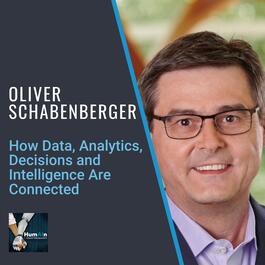
How Data, Analytics, Decisions and Intelligence Are Connected with Oliver Schabenberger of SingleStore
Oliver Schabenberger: How Data, Analytics, Decisions and Intelligence Are Connected [Audio] Podcast: Play in new window | Download Subscribe: Google Podcasts | Spotify | Stitcher | TuneIn | RSS Oliver Schabenberger is the Chief Innovation Officer at SingleStore. He is a former academician and seasoned technology executive with more than 25 years of global experience in data management, advanced analytics, and AI. Oliver formerly served as COO and CTO of SAS, where he led the design, development, and go-to market effort of massively scalable analytic tools and solutions and helped organizations become more data-driven. Previously, Oliver led the Analytic Server R&D Division at SAS, with responsibilities for multi-threaded and distributed analytic server architecture, event stream processing, cognitive analytics, deep learning, and artificial intelligence. He has contributed thousands of lines of code to cutting-edge projects at SAS, including, SAS Cloud Analytic Services, the engine behind SAS Viya, the next-generation SAS architecture for the open, unified, simple, and powerful cloud. He has a PHD from Virginia Polytechnic Institute and State University Please support this podcast by checking out our sponsors: Episode Links: Oliver Schabenberger’s LinkedIn: https://www.linkedin.com/in/oschabenberger/ Oliver Schabenberger’s Twitter: https://twitter.com/oschabenberger?s=20 Oliver Schabenberger’s Website: https://www.singlestore.com/ Podcast Details: Podcast website: https://www.humainpodcast.com Apple Podcasts: https://podcasts.apple.com/us/podcast/humain-podcast-artificial-intelligence-data-science/id1452117009 Spotify: https://open.spotify.com/show/6tXysq5TzHXvttWtJhmRpS RSS: https://feeds.redcircle.com/99113f24-2bd1-4332-8cd0-32e0556c8bc9 YouTube Full Episodes: https://www.youtube.com/channel/UCxvclFvpPvFM9_RxcNg1rag YouTube Clips: https://www.youtube.com/channel/UCxvclFvpPvFM9_RxcNg1rag/videos Support and Social Media: – Check out the sponsors above, it’s the best way to support this podcast – Support on Patreon: https://www.patreon.com/humain/creators – Twitter: https://twitter.com/dyakobovitch – Instagram: https://www.instagram.com/humainpodcast/ – LinkedIn: https://www.linkedin.com/in/davidyakobovitch/ – Facebook: https://www.facebook.com/HumainPodcast/ – HumAIn Website Articles: https://www.humainpodcast.com/blog/ Outline: Here’s the timestamps for the episode: (00:00) – Introduction (01:38) – From forestry to statistics to Software development to advance analytics (04:07) – To understand the data is not only to build a mental model, but a probabilistic model of how the data came about, and once that model is accepted, as a good abstraction, then it is used to ask questions about the world. (05:39) – Many of the assumptions into our established models and established thinking about industries and supply chains had to be questioned because of unforeseen events like the pandemic. Scenario modeling is not just making a prediction, it must also guide the decisions and the need to provide the right abstractions. (07:19) – There is an approach steeped in mathematical statistics and probability theory. And a more computationally-driven approach which shows how computer science, as a discipline, changed its focus from focus on compute, to focus on data. (10:34) – There are transactional systems, analytics systems, machine learning and data science, all somewhat based on existing technology purpose-built for a certain use case, and what we're seeing is the use cases coming together. These worlds need to come together through a data foundation where the workloads can all converge. Silos and empires that need to be connected. (16:15) – The explosion of neural network technology over the last 15 years due to the availability of big compute and cloud computing has allowed to solve much deeper problems, and we need larger amounts of data to train those models. (16:33) – Modern AI, data-driven AI and machine learning applications recognize patterns. Neural networks are trained to detect patterns. The next generation of models might be more contextual or build out from individual component models where humans can interact with the system and understand how it drives its conclusion, and then correct it. (20:35) – We need to empower all of us to work with data and to contribute to driving the world with data and driving the world with models more. We need to be more data literate. But we also need better tooling that allows low-code and no-code contributions (23:28) – The future of data science is decision science. (25:38) – We have technology at our disposal, that makes us “prosumers” who consume and produce at the same time. And data should be the same way. We should be able to produce what we need based on data, not just consume. (28:28) – Innovation is key to success in technology. Innovation is about turning creativity and curiosity into value, and value has to be tied to the core of what we do, core of the business, core of what our customer needs. (30:51) – The elements of building technology: connectivity, automation and culture. (32:43) – Turn the data into decisions and drive the business, and that is SingleStore’s specialty. Advertising Inquiries: https://redcircle.com/brands Privacy & Opt-Out: https://redcircle.com/privacy
From "HumAIn Podcast"




Comments
Add comment Feedback